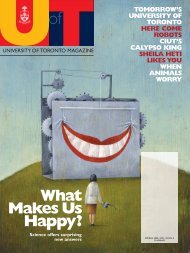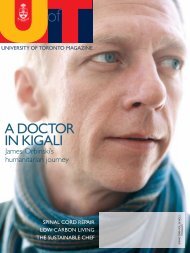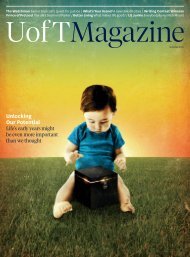What's the solution to Toronto's traffic problems? - University of ...
What's the solution to Toronto's traffic problems? - University of ...
What's the solution to Toronto's traffic problems? - University of ...
You also want an ePaper? Increase the reach of your titles
YUMPU automatically turns print PDFs into web optimized ePapers that Google loves.
ecommended <strong>the</strong> LRT, which garnered significantly higher<br />
ratings than <strong>the</strong> o<strong>the</strong>r two, and after two days <strong>of</strong> intense debate,<br />
council voted 24 <strong>to</strong> 19 for <strong>the</strong> LRT option. Ford, for his part,<br />
flatly rejected <strong>the</strong> panel’s findings, insisting that Toron<strong>to</strong>nians<br />
want subways, not LRT.<br />
ressed in a crisp navy suit with an Ontario legislature<br />
lapel pin, John Tory strides in<strong>to</strong> O&B Canteen, <strong>the</strong><br />
stylish eatery in <strong>the</strong> TIFF Bell Lightbox, and bangs out<br />
a quick text on his smartphone before settling in <strong>to</strong> discuss<br />
transit politics. Despite a bit more grey hair and a postpolitics<br />
gig on talk radio, Tory (BA Trinity 1975) is every bit<br />
as engaged in public life as he was when he ran for mayor,<br />
in 2003, and <strong>the</strong>n led <strong>the</strong> Ontario Progressive Conservatives,<br />
from 2004 <strong>to</strong> 2009. These days, he’s using his platform as<br />
chair <strong>of</strong> CivicAction, a Toron<strong>to</strong> lobby group, <strong>to</strong> convince<br />
<strong>the</strong> McGuinty government <strong>to</strong> establish a long-term revenue<br />
source <strong>to</strong> finance The Big Move.<br />
The strategy involves assembling a GTA-wide coalition<br />
<strong>of</strong> labour, business, not-for-pr<strong>of</strong>it and institutional leaders<br />
who are willing <strong>to</strong> back policies that will likely involve asking<br />
<strong>the</strong> region’s residents <strong>to</strong> pay more <strong>to</strong> alleviate <strong>traffic</strong> snarls.<br />
The PR campaign, expected <strong>to</strong> be in full swing by <strong>the</strong> fall,<br />
won’t include new transportation studies; nor does Tory intend<br />
<strong>to</strong> get in<strong>to</strong> <strong>the</strong> policy weeds. “The people <strong>of</strong> <strong>the</strong> region are<br />
desperate <strong>to</strong> see actions taken <strong>to</strong> create a viable transit system,”<br />
he says. They know <strong>the</strong>re’s been little progress “whe<strong>the</strong>r<br />
<strong>the</strong>y’re driving <strong>the</strong>ir car or waiting for four trains <strong>to</strong> go by <strong>to</strong><br />
get on <strong>the</strong> Yonge subway.” But <strong>to</strong> solve <strong>the</strong> worsening gridlock<br />
issues, he adds, “<strong>the</strong>y’re going <strong>to</strong> have <strong>to</strong> pick <strong>the</strong>ir poison.”<br />
Metrolinx is working on a plan <strong>to</strong> underwrite <strong>the</strong> Big Move,<br />
which means finding ways <strong>to</strong> raise about $2 billion a year.<br />
Lessons from o<strong>the</strong>r cities have helped advance <strong>the</strong> debate.<br />
In recent months, U <strong>of</strong> T’s Institute on Municipal Finance and<br />
Governance invited key figures from o<strong>the</strong>r cities that have<br />
cracked <strong>the</strong> funding problem. Among <strong>the</strong> speakers was<br />
Richard Katz, a former California assemblyman who helped<br />
Los Angeles mayor An<strong>to</strong>nio Villaraigosa sell voters on a plan<br />
<strong>to</strong> raise $40 billion over 30 years by adding half a per cent <strong>to</strong><br />
<strong>the</strong> L.A. County sales tax.<br />
The tax, approved by plebiscite in 2008, is earmarked for<br />
more than a dozen major transit and transportation projects,<br />
as well as smaller improvements. “People have a sense that<br />
<strong>the</strong>ir tax dollars are getting in<strong>to</strong> <strong>the</strong> local community for<br />
something <strong>the</strong>y can see,” says Enid Slack, direc<strong>to</strong>r <strong>of</strong> <strong>the</strong><br />
municipal finance institute. “The ‘aha moment’ is that even<br />
in a time <strong>of</strong> fiscal restraint and a time <strong>of</strong> people wanting<br />
lower taxes, [L.A. residents] could agree <strong>to</strong> be taxed for things<br />
<strong>the</strong>y can see and benefit from.”<br />
Yet an L.A.-style retail sales tax – seen as acceptable by<br />
between half and three-quarters <strong>of</strong> <strong>the</strong> GTA’s population,<br />
according <strong>to</strong> various polls – isn’t a complete <strong>solution</strong> because<br />
it doesn’t encourage drivers <strong>to</strong> use transit. One approach used<br />
in o<strong>the</strong>r cities is a regional parking levy. Studies have shown<br />
that higher parking fees and fewer spaces down<strong>to</strong>wn encourage<br />
people <strong>to</strong> use transit. But in suburban areas, where drivers<br />
have long been accus<strong>to</strong>med <strong>to</strong> free parking in malls and <strong>of</strong>fice<br />
complexes, <strong>the</strong> impact is more difficult <strong>to</strong> predict because<br />
transit isn’t yet a viable alternative for most people.<br />
Such chicken-and-egg dilemmas bedevil <strong>the</strong> debate about<br />
transit expansion. People need travel options besides cars,<br />
says Miller, who suggests “demand management” <strong>to</strong>ols<br />
such as gas taxes, road <strong>to</strong>lls on <strong>the</strong> 400-series highways or<br />
congestion charges, like those used in down<strong>to</strong>wn London <strong>to</strong><br />
dissuade people from driving in<strong>to</strong> <strong>the</strong> city core at certain<br />
times <strong>of</strong> <strong>the</strong> day. “Managing <strong>the</strong> use <strong>of</strong> <strong>the</strong> roads is important,”<br />
he says (though he adds he doesn’t think London’s congestion<br />
charge would translate well <strong>to</strong> Toron<strong>to</strong>).<br />
While he acknowledges that road pricing is <strong>of</strong>ten seen as<br />
<strong>the</strong> third rail <strong>of</strong> local politics, Miller feels <strong>the</strong> issue is <strong>of</strong>ten<br />
framed incorrectly: “We typically ask <strong>the</strong> wrong question. It’s<br />
always viewed as a tax for which <strong>the</strong>re is no benefit.” In fact,<br />
experience elsewhere shows some drivers are willing <strong>to</strong> pay<br />
more <strong>to</strong> reach <strong>the</strong>ir destination more quickly because <strong>the</strong><br />
benefit <strong>the</strong>y receive is immediate.<br />
The riddle is that <strong>the</strong>re is no GTA-wide political body, like<br />
L.A. County, that can formally levy <strong>the</strong>se taxes and <strong>the</strong>n be<br />
held accountable for <strong>the</strong>ir use. Nor is it clear how <strong>the</strong> region’s<br />
residents would express <strong>the</strong>ir views on such proposals. “We<br />
don’t do referenda here in Ontario, but <strong>the</strong>re’s still a question<br />
<strong>of</strong> how do you get public support,” Slack observes, adding<br />
that she’s not opposed <strong>to</strong> <strong>the</strong> province giving local municipalities<br />
<strong>the</strong> right <strong>to</strong> use a range <strong>of</strong> levies but <strong>the</strong>n letting each<br />
council decide if <strong>the</strong>y wish <strong>to</strong> impose one.<br />
Tory, for his part, believes that it would be possible <strong>to</strong> hold<br />
and win a referendum, but he feels that <strong>the</strong> decision should be<br />
made at Queen’s Park. On <strong>the</strong> latter point, Prichard agrees:<br />
“The ultimate decider is <strong>the</strong> legislature <strong>of</strong> Ontario.” He doesn’t<br />
think that it’s possible <strong>to</strong> achieve consensus by putting <strong>the</strong>se<br />
questions <strong>to</strong> each <strong>of</strong> <strong>the</strong> GTA and Hamil<strong>to</strong>n’s 31 municipalities.<br />
“It seems <strong>to</strong> me it has <strong>to</strong> be a region-wide initiative.”<br />
Even if <strong>the</strong> provincial Liberals take Metrolinx’s forthcoming<br />
advice and impose various taxes, levies and fees on GTA residents<br />
<strong>to</strong> pay for <strong>the</strong> Big Move, <strong>the</strong> issue <strong>of</strong> how and when <strong>to</strong><br />
spend those dollars remains something <strong>of</strong> an open question.<br />
Transit watchers are eagerly awaiting next year’s release <strong>of</strong><br />
a refined version <strong>of</strong> <strong>the</strong> Big Move. But experts remain divided<br />
about how <strong>the</strong> agency should target its investments. U <strong>of</strong> T<br />
economist Gilles Duran<strong>to</strong>n argues that new revenues should<br />
be invested in high-speed bus service, using comfortable,<br />
state-<strong>of</strong>-<strong>the</strong>-art vehicles, because subways and LRT lines<br />
only make sense in areas with high population densities.<br />
“The idea that you build subways and <strong>the</strong>n buildings will go<br />
up is just so fanciful.”<br />
André Sorensen, however, argues that Metrolinx remains<br />
overly focused on expanding GO bus service, particularly<br />
<strong>to</strong> Union Station. “It doesn’t really create a regional transit<br />
42 www.magazine.u<strong>to</strong>ron<strong>to</strong>.ca

















